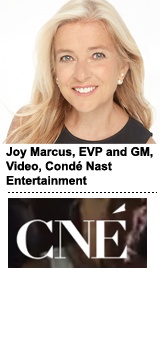 Like other digital publishers, Condé Nast wasn’t immune to the challenges of scaling an upstart, owned-and-operated video property in a climate dominated by YouTube and Facebook.
Like other digital publishers, Condé Nast wasn’t immune to the challenges of scaling an upstart, owned-and-operated video property in a climate dominated by YouTube and Facebook.
In 2015, Condé Nast’s video hub, The Scene, struggled to hit its stride, despite owning a portfolio of popular titles that includes Vogue and Vanity Fair.
That’s changed, according to Joy Marcus, EVP and GM of video for Condé Nast Entertainment. The Scene is now “one of the most important brands” for Condé Nast on Facebook after it realigned the property around mobile video last spring and struck content partnerships with the likes of the NBA and CNN.
Condé Nast developed more original video aimed at viewers across social platforms, whether that was Snapchat Discover, Facebook or Pinterest. It also rolled out a custom content studio called Social Studio, which focuses on creating short, branded videos with the goal of stopping users mid-scroll.
Condé Nast says its renewed video strategy is paying off. Condé Nast reached 20 million unique video visitors in November, according to its latest comScore ranking, which is 58% higher than the year before. It banked 278 million total views that month, a 100% increase compared to 2015.
Marcus spoke with AdExchanger about Condé’s video strategy.
AdExchanger: Where is there greater opportunity for video? Social distribution or on Condé’s owned-and-operated properties?
JOY MARCUS: We try to do both thoughtfully. We have more than 100 million consumers who are interested in our specific brands enough to come to our owned-and-operated properties. It’s somewhat unique to us in that the brands are very strong on their own in the marketplace.
On the other hand, we know social channels are the superhighways of the internet. People use their social feeds as the new broadcast networks. We are embracing those channels to connect with those users because that’s how they consume media now.
How is Condé’s approach to video different?
We have a vast distribution network. We distribute on all the social platforms – in many cases with first sales rights – and we distribute on all of the digital portals people still visit. The AOL.com homepage still generates views for us, as does Yahoo.
Pinterest is looking to lean into male audiences, and we produced and distributed videos on Pinterest for GQ. They’ve done extremely well, and they’ve asked us to come back for a second look in January. On the other side of the house, we’re seeing GQ hitting over 1 million YouTube subscribers right now. We want all of our brands to resonate on social and on our O&O.
How has live video, such as Snapchat’s Live Stories and Facebook Live, performed for you?
We were early in on Facebook Live, so that arrangement allowed us to build out our live capabilities internally. I think there’s a sensibility around live video now that probably didn’t exist last year. We’ve had some breakout wins with the Democratic National Convention, when Glamour interviewed Chelsea Clinton. That video did exceptionally well, since it was an “of-the-moment” video. Our own proprietary player will be live-enabled as of [this month].
How does Condé package video audiences?
We look at our audience in total, and we sell across our different platform brands. There are many packages we put into the marketplace that are interest-based, so we package and fill around a beauty or fashion consumer. And that has existed for a while at Condé Nast.
In addition to audience, we encourage cross-pollination of video content. We have a single CMS across all of our brands, so if a celebrity is on a cover of one of our magazines over the course of a year, there will probably be a lot of videos in our CMS that pertain to that celebrity [that other pubs can use].
How does Condé Nast compete for viewer attention in a platform environment?
We are about content and brand and creativity, which is hard to replicate. It’s hard to become a scaled platform. There are a ton of folks creating a ton of content and not succeeding. I think what Condé Nast did right was we stayed content creators at heart. We’ve never been a pipe company.
The Scene is a good example of a nascent brand that was revived a year ago and is now killing it on Facebook. It was a place where we really hit a nerve with our audience, which wasn’t serviced well by other current video properties out there. Video became much more front and center than it ever had been for the company this year, both from an ad perspective but also from a content consumption perspective.
This post was syndicated from Ad Exchanger.

More Stories
BTS With Studs: The Gen Z-Friendly Challenger Taking on Claire’s
New CEO for Bastion ANZ
A Life in 3 Minutes: Swedish Lingerie Brand Debuts an Emotion-Packed Ad